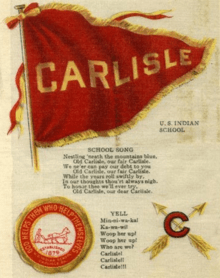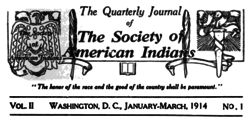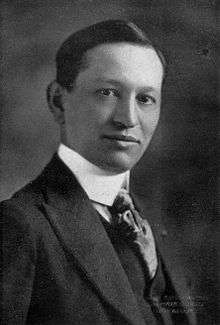Charles Edwin Dagenett

Charles Edwin Dagenett (September 17, 1873 - March 16, 1941) was the highest ranking American Indian in the Bureau of Indian Affairs for over 30 years, and from 1894 to 1927 served under six successive Commissioners of Indian Affairs. Dagenett was a founder and leader of the Society of American Indians (1911-1923), the first national American Indian rights organization run by and for American Indians. The Society pioneered twentieth-century Pan-Indianism, the philosophy and movement promoting unity among American Indians regardless of tribal affiliation. Dagenett is credited with creating the Office of Indian Employment at the Bureau of Indian Affairs and successfully employed thousands of American Indians in major labor-intensive projects and corporate industries.
Early Years

.png)
Dagenett was born into the Peoria tribe in Wea Township, Miami County, Kansas, son of Edward R. and Elizabeth Dagenett. His grandfather, Christmas Dagenett, was the agent of the Peoria Reservation in Miami, Oklahoma.[1] In 1887, at the age of 15, Dagenett entered the Carlisle Indian School in Carlisle, Pennsylvania, to learn the printing trade, and served as editor of The Red Man, the school magazine. After graduating as salutatorian in 1891, Dagenett attended Dickinson College and eventually graduated from Eastman College in Poughkeepsie, New York. On his return home to Kansas, he married Carlisle graduate Emerita Miller, a Miami, and together they started a weekly newspaper, The Miami Chief, which they printed on a small hand-press.[2] On April 15, 1916, Dagenett married Miss Cornelia Louise Skidmore.[3]
Office of Indian Employment
Dagenett was the highest ranking American Indian in the Bureau of Indian Affairs for over 30 years, serving under six successive Commissioners of Indian Affairs; Daniel M. Browning (1893–1897), William A. Jones (1897–1904), Francis E. Leupp (1904–1909), Robert G. Valentine (1909–1913), Cato Sells (1913–1921) and Charles Henry Burke (1921–1929). Dagenett is credited with creating the Office of Indian Employment at the Bureau of Indian Affairs and successfully employing thousands of American Indians in major labor-intensive projects such as railroad, dam construction and large-scale agriculture ventures.

In 1894, Dagenett joined the Bureau of Indian Affairs, working first with the Lower Yanktonai (Nakota) at the Crow Creek Reservation, Fort Thompson, South Dakota, and then with Apache prisoners of war at Fort Apache, Arizona. From 1896 through 1898, Dagenett was at the Chilocco Indian School in Oklahoma, where he worked his way up from teacher to disciplinarian to clerk. He was offered a reservation superintendency but turned it down. Since his student days, Dagenett had been developing a plan that applied the principle of the Carlisle Indian School "Outing Program" on a national scale. In spring 1905, with the help of Indian Commissioner Francis Ellington Leupp, Dagenett persuaded Congress to create an Office of Indian Employment, of which he was appointed supervisor, with his headquarters first in Albuquerque, then Denver, with a larger office staff and more field assistants, and finally Washington, D.C.
.png)
Dagenett's job was to track down labor-intensive projects, such as railroad, dam construction and large-scale agricultural ventures, bargain with the employer to accept a certain number of Indian workmen, and then notify agency superintendents in the area as to the number of men wanted, the kind of work and the wages. Dagenett placed 600 men in his first season, and by summer 1906 he had placed 1,100 on the Salton Sea flood control project in Southern California; some 200 on the construction of the Saint Mary's Canal on the Blackfeet Reservation in Montana; more than 200 ballasting on the Santa Fe Railroad; 600 in the sugar-beet fields at Rocky Ford, Colorado; and about 3,000 in other activities, including sheepherding, lumbering, cantaloupe growing, road construction and irrigation projects. The Zuni Dam at Black Rock, New Mexico, was also built by Indian labor. A supervisor with each crew acted as liaison to the employer and was responsible for scheduling, helping the men with problems, and overseeing their health. Though the Indians had to pay for food, clothing and supplies out of their wages, it was reported that they still took home between 60 and 93 percent of the proceeds. Many Indians who showed aptitudes for special kinds of work received training and became skilled workers.
.png)
In 1907, with winter approaching, President Theodore Roosevelt sent Dagenett to Thunder Butte, South Dakota, to deal with a band of starving White River Ute who had left their reservation in protest against allotment and Mormon encroachments on their land. They asked the government to take them home, but Dagenett helped them set up a winter camp and made them work for their passage. He got them hired on the construction of a railroad in the Black Hills, and as the wages were good, many stayed on until summer. During his career, Dagenett made official trips to Canada, Mexico, Puerto Rico, and South America.
In 1908, Commissioner Valentine praised Dagenett for his activities placing Indians as workers on railroads, farms and "sundry employment which their strength and abilities are equal." [4]
In 1910, Carlisle's The Red Man noted that a large saw and planing mill on the Menominee Reservation, in Menominee, Wisconsin, was almost entirely operated with Indian labor. "Even the assistant engineer in charge of the power plant is an Indian." [5]

During the winter of 1910—1911, Dagenett spent three weeks in the Florida Everglades investigating conditions among the isolated Seminole. With the outbreak of World War I, Dagenett was able to place many Indian mechanics in the expanding American auto industry. In September 1912, in the waning days of the William Howard Taft administration, the president consulted with Dagenett in regard to the post of Indian Commissioner, recently vacated by Robert Grosvenor Valentine. By 1913, there were some 2,300 Indians working for the Indian Service, and as Dagenett held the highest office of any, he was an important figure. At the outset of his appointment, Francis Leupp had told Dagenett that "his future career in the Service was dependent on his carrying the experiment to success." Dagenett was valued and served subsequent commissioners Robert Valentine (1909–1913), Cato Sells (1913–1921) and Charles Henry Burke (1921–1929).
By 1917, the Willys-Overland Company in Toledo, Ohio, employed a score of Indians from various tribes.
By 1922, a dozen of the leading manufacturers of automobiles had constant orders in with the Indian Service and the trade schools for young men to serve as apprentices in their factories and to learn the automobile business. The manufacturers reported that "the Indians rank among the best mechanics that they employ, and they do not talk during working hours and do not waste as much time as some of the other motor mechanics." [6]
Society of American Indians


At the time of the founding of the Society of American Indians, Dagenett was the highest ranking American Indian in the Bureau of Indian Affairs.[7] His friend and associate Arthur C. Parker, writing in 1914, described Dagenett's position as "one of the most vital that a man can hold in the Indian Service," adding that "Mr. Dagenett is fearless in his recommendations to the Indian Bureau, and I have more than once witnessed his struggle to obtain justice for his brother Indian."
On April 3–4, 1911, at the invitation of Professor Fayette Avery McKenzie, six American Indian intellectuals attended a planning meeting at Ohio State State University. The attendees were Charles E. Dagenett, (Peoria), Bureau of Indian Affairs supervisor; Dr. Charles Eastman, (Santee Dakota), physician; Dr. Carlos Montezuma, (Yavapai-Apache), physician; Thomas L. Sloan, (Omaha), attorney; Laura Cornelius Kellogg, (Oneida), educator; and Henry Standing Bear, (Oglala Lakota), educator. Arthur C. Parker, (Seneca), an anthropologist, was also invited to the meeting, but a fire at the New York State Capitol, which housed the New York State Museum where he served as an archeologist, precluded his attendance.[8] Shortly after the April meeting, a Temporary Executive Committee was formed, consisting of 18 prominent Indians with Dagenett as Chairman; Laura Kellogg Cornelius (Oneida), Secretary; and Rosa La Flesche (Chippewa), Corresponding Secretary and Treasurer.[9]
On June 21 and 22, 1911, the Executive Committee met at the home of Laura Cornelius Kellogg in Seymour, Wisconsin, attended by prominent Oneida attorneys Chester Poe Cornelius and Dennison Wheelock.[10] Dagenett had the chair, with Emma Johnson, Rosa LaFlesche and Prof. Fayette Avery McKenzie in attendance.[11]
On October 12, 1911, the Society’s inaugural conference was convened on the campus of the Ohio State University in Columbus, Ohio, symbolically held on Columbus Day as a fresh beginning for American Indians.[12] From October 12–17, 1911, approximately 50 prominent American Indian scholars, clergy, writers, artists, teachers and physicians attended the historic event, and was reported widely by national news media.[13] The Society was formally welcomed by university and city officials, and a personal address by the U.S. Commissioner of Indian Affairs, Robert G. Valentine.[14] During the business session attended by Indian delegates only, Dagenett, declined to continue as Executive Committee Chairman, was elected Secretary-Treasurer. Thomas L. Sloan, Rev. Sherman Coolidge and Dr. Charles Eastman were nominated for Chairman and Sloan won.
Dagenett's election as Secretary-Treasurer contributed to suspicion among Indians of white control of the Society. Many Indians regarded the Bureau with contempt and that Indians affiliated with the Bureau worked against the race. McKenzie noted that “a considerable body of Indians are positively afraid of and opposed to the government,” and that they feel “a government employee is not morally free to express his own independent judgment.” Society leaders debated whether the Bureau of Indian Affairs and federal reservation system should be abolished and whether employees of the Bureau holding offices could be loyal to the "race" and the Society. Dr. Carlos Montezuma and Father Philip B. Gordon believed it was not possible for a member in the employment of the government to be at the same time loyal to the Society, while Rev. Sherman Coolidge, Marie Baldwin and Gertrude Bonnin maintained it was possible an employee of the Indian Service to be an equally loyal to his race and to his government.[15] Montezuma detested the Bureau of Indian Affairs and reservation life, and soon became convinced the Society was a puppet of the Bureau. At the fifth annual conference in Lawrence, Kansas, September 28–October 3, 1915, Rev. Coolidge was re-elected President and Parker as Secretary, and Daganett, then first Vice-President, was replaced by William A. Durant (Choctaw). Afterwards, Daganett and Rosa B. Laflesche, the assistant secretary in the Washington office, withdrew from Society affairs.[16] The Bureau was a major employer of American Indians and the debate regarding “race loyalty” virtually eliminated one of the Society’s major constituencies.
Later years

In 1927, Dagenett retired for reasons of health and he spent most of the year in a log cabin in the Ouachita Mountains near Mena, Arkansas, returning home to Tulsa only for the winter. Charles Dagenett died on March 16, 1941, in Tulsa, Oklahoma.[17]
External Sources
References
- ↑ Hazel W. Hertzberg, "The Search for an American Indian Identity: Modern Pan-Indian Movements" (hereinafter "Hertzberg"), Syracuse University Press, 1971, p.42-43.
- ↑ Hertzberg, p.42.
- ↑ The Washington Evening Star, Monday, April 24, 1916.
- ↑ Tom Holm, The Great Confusion in Indian Affairs: Native Americans and Whites in the Progressive Era, f.48, (2005).
- ↑ Moses Friedman, "Indians Who Have 'Made Good': Charles E.Dagenett, National Supervisor of Indian Employment", The Red Man, Vol.2, No.8, April 10, 1910, p.39.
- ↑ Alexander Ewen and Jeffrey Wollock, "Dagenett, Charles E.", Encyclopedia of the American Indian in the Twentieth Century, 2014.
- ↑ Hertzberg, p.42.
- ↑ Christopher L. Nicholson, “To Advance a Race: A Historical Analysis of the Personal Belief, Industrial Philanthropy and Black Liberal Arts Higher Education in Fayette McKenzie’s Presidency at Fisk University, 1915–1925”, Loyola University, Chicago, May 2011, p.64.
- ↑ Nicholson, p.64.
- ↑ Laurence M. Hauptman, Seven Generations of Iroquois Leadership: The Six Nations Since 1800, (2008), p.149.
- ↑ Philip J. Deloria, “Four Thousand Invitations”, SAIL 25.2/AIQ 37.3 Summer 2013, p.28.
- ↑ David E. Wilkins, "American Indian Politics and the American Political System, (2007), p. 218-219.
- ↑ Only 44 active members are listed in the program as being in attendance at the conference, out of a little more than 100 active members in total. The non-Indian Associates, 125 of them, outnumbered the Indians. Philip J. Deloria, “Four Thousand Invitations”, SAIL 25.2/AIQ 37.3 Summer 2013, P. 28.
- ↑ Hertzberg, p.60.
- ↑ Hertzberg, p.148.
- ↑ Hertzberg, p. 137, 153.
- ↑ Alexander Ewen and Jeffrey Wollock, "Dagenett, Charles E.", Encyclopedia of the American Indian in the Twentieth Century, 2014.
